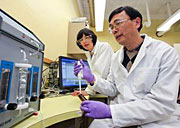- Number 329 |
- January 24, 2011
Mercury cycling influenced by organic matter

Findings by ORNL's Liyuan Liang
(left) and Baohua Gu help
explain previously reported
seemingly contradictory findings.
Nature has a bit of a Jekyll and Hyde relationship with mercury, but researchers at DOE's Oak Ridge National Laboratory have made a <link>discovery that ultimately could help explain the split personality.
While scientists have known that microbes in aquatic environments make methylmercury, a more toxic form of mercury that accumulates in fish, they also know that nature and other types of bacteria can transform methylmercury to less toxic forms. What they haven't completely understood are the mechanisms that cause these transformations in anoxic environments -- lacking in oxygen -- in nature.
In a paper published in the Proceedings of the National Academy of Sciences, a team led by Baohua Gu of the the lab's Environmental Sciences Division reports that compounds from the decay of organic matter in aquatic settings affect mercury cycling. Low concentrations of these compounds can chemically reduce mercury, but as those concentrations increase, that reaction is greatly inhibited. They performed their experiments by simulating conditions found in nature.
"This study demonstrates that in anoxic sediments and water, organic matter is not only capable of reducing mercury, but also binding to mercury," said co-author Liyuan Liang. "This binding could make mercury less available to microorganisms for making methylmercury."[Ron Walli, 865.576.0226,
wallira@ornl.gov]
